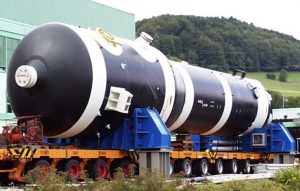The carbon content of the steam generators at Beznau and Gösgen is not too high
The steam generators at Beznau and Gösgen do not deviate from the design requirements in terms of their carbon content. This is the result of a review of the manufacturing documents. The structural integrity of the steam generators’ individual components is ensured by a large margin.
“Compliance with the manufacturing specifications has been confirmed for all steam generator forgings,” says Georg Schwarz, Deputy Director of the Swiss Federal Nuclear Safety Inspectorate (ENSI) and Director of the NPPs Division, giving his summary of the review’s results. “In ENSI’s view, no further action is required based on these findings.”
 The review showed that the risk of a greatly elevated carbon content in the steam generators’ components is low to very low. An elevated carbon content was only detected in the tube plate of a steam generator at the Beznau nuclear power plant. However, this is still below the maximum value permitted by the American Society of Mechanical Engineers (ASME). Moreover, the Beznau nuclear power plant has explained that the tube plates’ structural integrity is guaranteed by a large margin even in the case of a potentially elevated carbon content.
The review showed that the risk of a greatly elevated carbon content in the steam generators’ components is low to very low. An elevated carbon content was only detected in the tube plate of a steam generator at the Beznau nuclear power plant. However, this is still below the maximum value permitted by the American Society of Mechanical Engineers (ASME). Moreover, the Beznau nuclear power plant has explained that the tube plates’ structural integrity is guaranteed by a large margin even in the case of a potentially elevated carbon content.
Segregation leads to elevated carbon content
The large components of nuclear power plants are generally forged from a block that has first been cast.
The solubility of various additional elements, such as carbon, for example, is lower in the solid than in the molten material. As a result, segregations are formed as the casting cools. Because the molten material solidifies from the outside inwards, the centre of the casting solidifies last and is affected by the segregations the most.
A distinction is made between two types of carbon segregation:
- Positive segregation: a zone at the top of the casting with carbon concentrations above the specified values.
- Negative segregation: a zone at the bottom of the casting with carbon concentrations below the specified values.
A greatly elevated carbon content increases the tensile strength and yield point, but the resistance to brittle fracture decreases as a result of the decreasing ductility. The zone showing positive carbon segregation is therefore important.
During both the forging and the subsequent machining of the casting, the majority of these segregation zones are typically removed by cutting. If not enough material is cut off, the finished component can contain positive carbon segregation zones that exceed the specified value.
This particularly affects parts forged from large castings in which the centre of the casting was not removed. In the case of steam generators, these are the water box, the tube plate and the cover cap .
Where components form part of a nuclear power station’s primary circuit, it must be ensured that they withstand the loads that occur and that they fulfil their function. Based on these requirements, alloy steels with a maximum carbon content of up to 0.25% are used for the steam generator parts, such as the water boxes and tube plates .
ENSI demanded a review following reports from France
In June 2016, ENSI called on the plants to gather information and to investigate whether components from the forging works Le Creusot Forge – with potential deficiencies in their production documentation – had been or were still in use. All plants were able to confirm that the manufacturing and material certificates for all forgings used in important safety-relevant components are documented in full.
In parallel to this, but independently of the falsification issue, information became available from France about potential material problems in the steam generators of pressurised water reactors. In a series of reactors, the forged steel components of the steam generators showed an elevated carbon content. In late 2016, this in turn prompted ENSI to call for the inspection of the steam generators at the Swiss nuclear power plants with pressurised water reactors, i.e. Beznau and Gösgen. The documents were submitted on time by the operators in spring 2017 and examined by ENSI with the assistance of the Swiss Association for Technical Inspections (SVTI).

